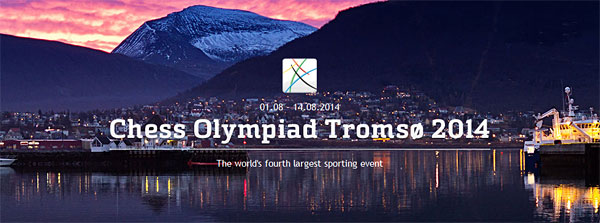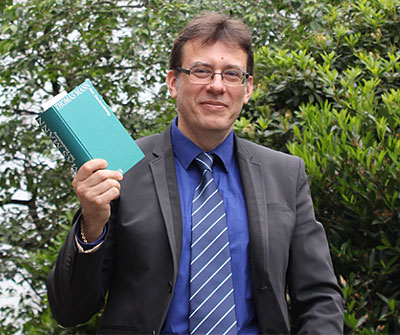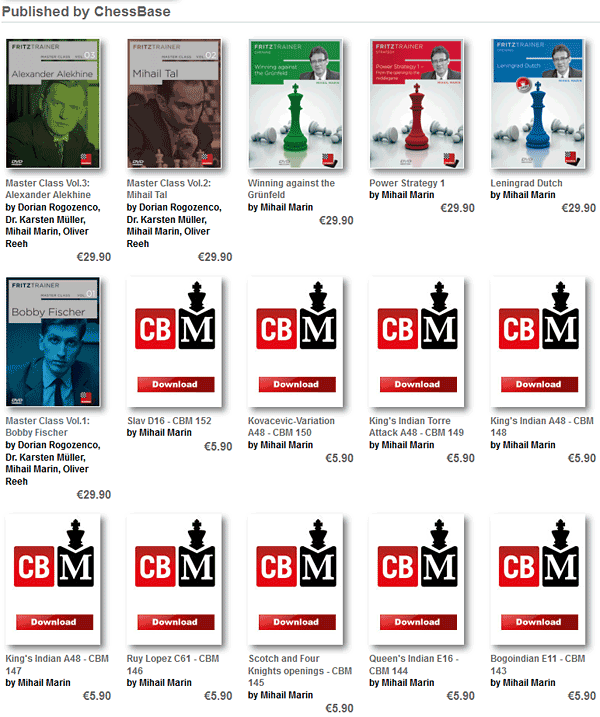
Marin on Tromso – round one selection

GM Mihail Marin, born in 1965, has several times been Romanian champion and first made the leap over the Elo barrier of 2600 in 2001. Marin possesses a rare gift for a grandmaster – he is able to explain in readily comprehensible terms the ideas behind moves, variations and positions. This ability is there for all to admire in his contributions to ChessBase Magazine. Marin has written some books which have earned the highest of praise, among which are "Secrets of Chess Defence" and "Learn from the legends". Marin lives in Bucharest and is married to women's International Master Luiza Marin.

[Event "41st Olympiad Tromso 2014 Open"] [Site "Tromsø"] [Date "2014.08.02"] [Round "1"] [White "Haddouche, Mohamed"] [Black "Balogh, Csaba"] [Result "0-1"] [ECO "A04"] [WhiteElo "2508"] [BlackElo "2637"] [Annotator "Marin,Mihail"] [PlyCount "94"] [EventDate "2014.??.??"] [EventCountry "NOR"] [WhiteTeam "Algeria"] [BlackTeam "Hungary"] [WhiteTeamCountry "ALG"] [BlackTeamCountry "HUN"] {Ever since the swiss system has replaced the qualifying round-robin groups (Haifa 1976) the first round has been a warming up formality for the teams ranked in the first half of the list. There was only one exception, at Novi Sad 1990, when the first round pairing was done according to the accelerated system, making that, for instance, the Soviet Union met the strong team of the Democratic Germany. But that was just an exception, and in the year of grace 2014 the first round scheduled matches between teams with a difference of average rating of about 400 or even 500 points! At individual level, things may get less comfortable, though. Many modest teams have International Masters and even grandmasters on the top board. So, if you are rated above 2600 you could hope for a 2100 opponent, but... should also be prepared for a tough one! No time to walk around through the playing hall, greeting old friends you haven't seen for two years and spreading smiles all around, no sir! Just sit at the board and stay fully focused! And yet, there seems to be some even bigger pressure for the somewhat lower rated grandmaster, too. There is not much to be expected from the match anyway and one can only complain about the few missing positions up to the first half of the intiial ranking, yielding a really easy first round game! Be it as it may, in the games I have selected to illustrate this interesting first round issue the stronger player got a big advantage surprising easily.} 1. e4 c5 2. Nf3 e6 3. d3 {A solid move, but not just so. The Indian attack has served well the ever aggressive Bronstein and has occasionally been used by Fischer.} Nc6 4. g3 Nge7 5. Bg2 g6 6. O-O Bg7 7. c3 O-O 8. Re1 e5 $5 {Consolidating the control on dark squares and preventing d2-d4. In my English trilogy I have advocated Botvinnik's triangle setup (c4, d3, e4, Nge2) which seems to be so good that, as proven by this game, is working even with two tempi down! (one of them is spent on "reverting colours" and the other one by the "hesitant" advance of the e-pawn).} ({The classical continuation is} 8... d5 9. e5 {, causing Black some problems on dark squares.} ) 9. a3 d6 10. b4 b6 11. Nbd2 Be6 12. Bb2 h6 {White's position looks more flexible, but he has one important problem. If his fails finding ways for developing his initiative in the centre or on the queenside, . ..f7-f5 would offer Black chances for a kingside attack.} 13. d4 $6 {Effectuated after 19 moves, this plays into Black's hands.} ({The natural} 13. b5 {would cause Black some space problems, but after blocking the queenside White may have real worries about ...f7-f5.}) ({The mysterious rook move} 13. Rb1 {typical for the long lines of the Ruy Lopez also deserves attention. The main idea is to prepare d3-d4, as in the game White will have to plai Ra1-b1 anyway.}) 13... exd4 14. cxd4 cxb4 15. axb4 Nxb4 16. Ba3 a5 17. Rb1 {White probably hoped to retrieve the pawn and get long term pressure against the weak b6-pawn.} d5 $1 { A strike in the centre is some sort of panacea to wing actions, of course.} 18. Bxb4 ({The point is that after stabilizing the centre with} 18. e5 {White would not retrieve the pawn anymore due to} Nec6 {. But retrospectively this might have offered better chances to stay in the game.}) 18... axb4 19. Rxb4 dxe4 20. Nxe4 Nc6 21. Rb2 Nxd4 {Black won a pawn and has two mighty bishops. Although the game lasted for quite a while, the final result was obvious all the way.} 22. Nxd4 Qxd4 23. Rd2 Qb4 24. h3 Ra1 25. Qe2 Rxe1+ 26. Qxe1 b5 27. Kh2 Kh7 28. h4 Bf5 29. h5 Re8 30. Re2 Qxe1 31. Rxe1 Kh8 32. hxg6 Bxg6 33. Re3 b4 34. Nc5 Rc8 35. Nb3 Rc2 36. Kg1 Bc3 37. Bd5 Kg7 38. Rf3 Rb2 {White has managed to block the passed pawn, but with the knight far from the kingside and the bishop tied up to its defence, the kingside is vulnerable. Balogh will gradually increase his pressure until creating deadly mating threats.} 39. Kh2 Rb1 40. Nc5 Rd1 41. Be4 Bh5 42. Rf5 Bg4 43. Rd5 Re1 44. f3 Re2+ 45. Kh1 Bh3 46. g4 Bd2 47. Rd3 Bf4 {Even without the engine's "- zillions" it is obvious that the white king is doomed.} 0-1

[Event "41st Olympiad Tromso 2014 Open"] [Site "Tromsø"] [Date "2014.08.02"] [Round "1"] [White "De La Riva Aguado, Oscar"] [Black "Giri, Anish"] [Result "0-1"] [ECO "B31"] [WhiteElo "2523"] [BlackElo "2745"] [Annotator "Marin,Mihail"] [PlyCount "52"] [EventDate "2014.??.??"] [EventCountry "NOR"] [WhiteTeam "Andorra"] [BlackTeam "Netherlands"] [WhiteTeamCountry "AND"] [BlackTeamCountry "NED"] {Playing on the top board of a small team like Andorra can be profitable. The modest scoring of the colleagues would result into comfortable pairings, with chances for a good individual percentage. For many years, the team was headed by IM Raul Garcia, who once (in Novi Sad 1990) conquered an individual gold medal! Oscar De la Riva was less fortunate, as his best result was good for the fifth place on the top board, at Calvia 2004. Oscar's "handicap" with respect to Raul might be that the rest of the team became more competitive (for instance, the ever hard to beat Raul dropped on the third in the meanwhile), making the pairings a bit tougher. Be it as it may, the sad news when playing for a small team is that you may start the Olympiad with a game against a super-star, rather than a warming-up one.} 1. e4 c5 2. Nf3 Nc6 3. Bb5 g6 4. O-O Bg7 5. Re1 Nf6 6. c3 O-O 7. h3 Qb6 8. Ba4 Rd8 $5 {A rare, but quite logical move. Since White does not seem in a hurry to occupy the centre, Black prepares ...d7-d5, just to annoy the white queen.} 9. Bb3 $6 {A unfortunate novelty. White delays his development too much. This special care for the light-squared bishop would be typical for an expert of the main Ruy Lopez lines. But for years Oscar used to be known rather as a specialist of the exchange variation, which would suggest leaving the bishop on a4 in order to be ready to chop the knight.} ({And recently the Scotch Opening became his main weapon, so why not take the space in the centre?} 9. d4 {True, Black does not have any special problems after} cxd4 10. cxd4 d5 11. e5 Ne4 {but when playing the Rossolimo one does not really hope for an objective advantage, but rather for just a playable position.}) 9... d5 10. e5 (10. exd5 Nxd5 {would make us remember an old Nimzovitsch' comment. Unpromoted pawn formations (c3, d2) tend to turn into weaknesses.}) 10... Ne4 11. d3 $2 {A heavy mistake after more than three quarters of an hour.} ({White would still be alive after} 11. d4 Bf5 {but the bishop stands worse on b3 than it was on a4 and Black has also an extra tempo with respect with the similar line above.}) 11... c4 $1 { Suddenly, the opposition of the rook and queen along the d-file becomes a telling factor.} 12. Be3 Qc7 13. Bd4 ({The point is that} 13. dxe4 dxe4 {gains a vital tempo.} 14. Nd4 cxb3 $19 {Followed by ...Nxe5.}) 13... cxb3 14. axb3 { The knight is trapped, but, hey, it is the extra knight! Being better developed Black immediately starts dismantling White's centre.} f6 $1 {By far not the only move, but quite a convincing one. The rest is pure agony for White (or enjoyable formality for Black).} 15. dxe4 dxe4 16. Nfd2 f5 17. f3 Nxd4 18. cxd4 Rxd4 19. fxe4 fxe4 20. Rxe4 Qb6 21. Kh1 Bf5 22. Rxd4 Qxd4 23. Nc3 Bxe5 24. Ra4 Qd3 25. Qe1 Bg3 26. Qe2 Rd8 0-1

[Event "41st Olympiad Tromso 2014 Open"] [Site "Tromsø"] [Date "2014.08.02"] [Round "1"] [White "Jones, Gawain C B"] [Black "Jones, Richard S"] [Result "1-0"] [ECO "C43"] [WhiteElo "2665"] [BlackElo "2414"] [Annotator "Marin,Mihail"] [PlyCount "83"] [EventDate "2014.??.??"] [EventCountry "NOR"] [WhiteTeam "England"] [BlackTeam "Wales"] [WhiteTeamCountry "ENG"] [BlackTeamCountry "WLS"] {The last game features an almost perfect symmetry on various levels. Both players have international titles, the family names are identical, the represent teams from the same island and, as if this would not be enough, they played an opening with symmetrical structure! Why did I say "almost" then? Well, it is the result that spoils things...} 1. e4 e5 2. Nf3 Nf6 3. d4 Nxe4 4. Bd3 d5 5. Nxe5 Nd7 6. Nxd7 Bxd7 7. Nc3 Nxc3 8. bxc3 Bd6 9. Qh5 Qe7+ {As a crowning of the symphony of symmetry, an aesthetically perfect sequence of bishop moves follows:} 10. Be3 Be6 11. Bg5 Bg4+ $6 (11... Qd7 {would spoil the game, but allow Black hoping to defend an inferios position, in which his king does not have an obvious road to safety.}) 12. Bxe7 Bxh5 13. Bxd6 cxd6 14. Rb1 O-O-O 15. Rb5 {Just like that. The black bishop is not in time to defend the double pawn. The game is practically decided.} f6 16. Rxd5 Bf7 17. Ra5 Kb8 18. Kd2 Rc8 19. Rb1 Rhe8 20. Rab5 Re7 21. a4 h6 22. a5 Be8 23. R5b4 Bf7 24. f3 Rcc7 25. c4 Bg8 26. R1b3 Bf7 27. Rc3 Kc8 28. Rb5 Kd8 29. h4 Kc8 30. g4 Kd8 31. g5 fxg5 32. hxg5 hxg5 33. Rxg5 Bg8 34. c5 dxc5 35. Rcxc5 b6 36. axb6 axb6 37. Rb5 Rc6 38. Rbf5 Kc7 39. Rf8 Be6 40. Ra8 Bd7 41. Rg8 Rd6 42. c3 1-0
ChessBase DVDs by GM Mihail Marin

View all of GM Mihail Marin here
All you need to know about the Olympiad
- Full information on the games, the venue, the atmosphere and what's happening on and off the chessboard – 68 pages in PDF, 45 MB in size.
- All practical details you need to know before and after your arrival, including information about money, the climate, arriving at Oslo and Tromsø Airports, lost or delayed luggage, check-in at the hotels, the accreditation desk, information offices and the opening ceremony.
All ChessBase reports on the 2014 Olympiad in Tromsø



























